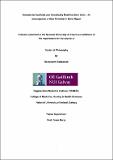| dc.description.abstract | The task of repairing large sections of bone tissue lost due to major trauma or pathology poses a significant challenge in orthopedic healthcare. The medical intervention often resorted to consists of a combination of grafting procedures, internal and external prostheses and fixation devices. However, the quantity of available harvested autologous bone is often not sufficient to create an effective graft. Very often the outcome is limited restoration of functional tissue. One example of such a condition is avascular necrosis (AVN) of the hip, which occurs when blood flow to a section of bone is interrupted. AVN typically affects people between the ages of 25 and 50, and between 30% and 70% of patients who are diagnosed with AVN in one hip will subsequently be diagnosed with the same disease in their other hip. Despite the high performance of current joint replacements, these patients may reasonably expect to require two or more revision surgeries in their lifetimes. These factors combine to make early intervention therapies that delay or remove the need for total hip replacement vital for the long-term management of this disease. Although many such treatments exist, the success rate is relatively low. A promising strategy is to devise methods that will lead to the restoration of functional bone tissue.
The objective of this research project is to develop a tissue engineered construct to enable bone regeneration and to restore the vascular supply. Two scaffolds were tested to evaluate osteoinductivity. Biosel, manufactured by DePuy Synthes (was the candidate material initially selected for the study).This material is fabricated as 3mm cubes consisting of 75% hydroxyapatite (HA) and 25% β-tricalcium phosphate (TCP). The Biosel scaffold provided a non-toxic environment capable of supporting cellular proliferation but did not enhance osteogenesis significantly.
The second material to be tested was microporous biphasic calcium phosphate (MBCP+, Biomatlante, France) which consisted of HA and TCP particles. The ratio of HA: TCP for this material is 20:80 .The MBCP+ scaffold provided an environment for cells to remain viable and proliferate like Biosel. Further, the MBCP+ scaffold, being particulate in nature, presented an environment with a greater degree of freedom, allowing populating cells to proliferate and self-synthesise a three-dimensional environment. Interestingly, although these scaffolds degraded faster than the Biosel, they supported osteogenesis even in the absence of osteogenic differentiation medium. Since the differentiation step can potentially be bypassed, the MBCP+ has several advantages- reduced time, cost and reduced risk of contamination.
In order to enhance angiogenesis, hMSCs were modified with a lentiviral vector to overexpress Ephrin B2, a molecule known for its pro-osteogenic and pro-angiogenic capabilities. Results indicated a significant enhancement of both osteogenesis and angiogenesis as indicated by increased calcium deposition and tubule formation in Ephrin B2 transduced hMSCs in comparison to controls. It was noted that hMSCs (both transduced and untransduced) displayed a reduction in their angiogenic potential following osteogenic induction.
Therefore, it is proposed to combine the spontaneous osteogenic differentiation capabilities of the MBCP+ and seed it with non-differentiated Ephrin B2 overexpressing hMSC (in order to take advantage of their potent angiogenic capabilities) which would result in a construct that would potentially prove highly therapeutic to the Avascular Necrotic environment. | en_IE |


